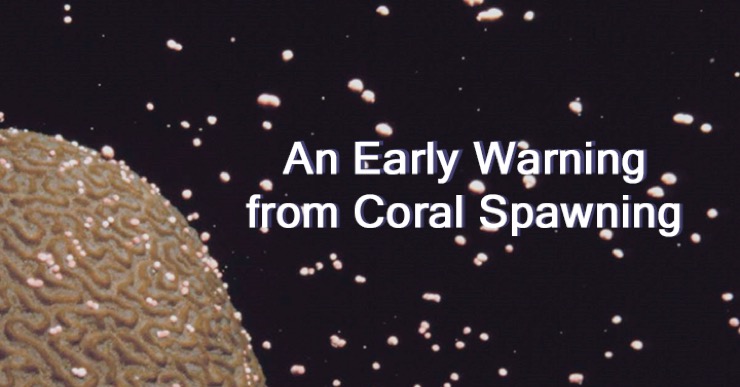


Relying on many cues in their environment, from moon phases and sunset times to sea temperature and wind speed, corals put on one of nature’s most astonishing displays. Often described as “the greatest orgy in the world,” coral spawning is a masterclass in synchronized behavior, explains Prof. Yossi Loya of Tel Aviv University. Prof. Loya and PhD candidate Tom Shlesinger have spent the last four years monitoring spawning events in various areas of the Red Sea. Since 2015, they have performed more than 225 nighttime field surveys during the annual reproductive season between June and September. Each survey lasted three to six hours as they recorded the spawning of every coral species they encountered.
Corals are capable of reproducing both sexually and asexually. When a parent polyp reaches a certain size, clonal polyps can bud off and form new coral colonies. Many species can also produce male or female gametes (sperm and egg cells). They release these at the same time as others of their species in a process known as broadcast spawning. With some species synchronizing within the same half-hour, coral spawning is a sight to see. Shlesinger, who has witnessed it in varying conditions around the world, describes it as “a colourful snowstorm”. Colourful gamete bundles drift upward from the coral in cloud-like formations. Synchronization is crucial because the chances of sperm and egg meeting in the open water are slim. Once the gametes combine, they form planulae, the free-floating larval stage of the coral life cycle. To improve survival in this vulnerable stage, corals release large numbers of gametes. Most planulae do not survive the journey from formation to settlement.
Five species of coral were studied and compared to a similar survey done on the same species between 1980 and 1983. The spawning of three of the five species had become erratic. Instead of releasing all their gametes in a single night, individuals released small asynchronous bursts of spawning over many nights. One example was the Brain Coral, *Platygyra lamellina*, which in 2018 spawned in big clumps every night from June 12 to July 18. These releases were not sufficient to create the dense “soup of gametes” needed for high fertilization success, especially after predation from fish.
To assess what effect this disorganized spawning was having on the coral population Loya and Shlesinger looked at the populations of juvenile coral. They found that for the three species that were now spawning more erratically two had no juvenile population at all and the third was severely limited. This indicated that the population of these species was ageing with no renewal from younger generations.
These findings lead them to believe that “some species that currently appear to be abundant may actually be nearing extinction through reproductive failure”.
This process of split spawning has been observed in nature before, explains Taryn Foster, a coral biologist at the California Academy of Sciences in San Francisco. Working off the coast of Australia, she observed that every two or three seasons corals on Scott Reef would release their gametes in two separate bursts. This process worked like a leap year, where the coral re-adjusted to the way moon phases cycle faster than annual cues, thus bringing about more synchronicity in the next season. However, the small, sporadic and extended releases seen in these Red Sea Corals were unlike these roughly equal and well-timed releases, leading her to worry about the fate of the out-of-sync corals.

A combination of factors are contributing to this decline. First is the rapidly rising temperatures in the region. The water in their studied area was warming at a rate of 0.31 degrees Celsius per decade which alone has a harmful effect on Coral Spawning. Warming oceans make it harder for coral to discern the time of year and to synchronize their gamete release. Confusion within mating patterns is what can be a “sub-lethal” effect of ocean warming. While it is not as apparent as coral bleaching unsynchronised spawning as a result of higher temperatures will still lead to coral mortality. Another plausible factor is the accumulation of hormonal/endocrine-disrupting pollutants; these are present in marine environments due to ongoing pollution from human activity.
While the report proposed no direct course of action to combat this problem, Shlesinger noted that these reproductive mismatches could act as early warning signs for the stress and mortality of coral species. By identifying vulnerable populations before there are any more visible and irreversible signs, future research and conservation efforts can be directed to reduce their decline. The importance of a sustainable ocean economy was discussed in a recent report published by a High Level Panel for a Sustainable Ocean Economy. As well as detailing the importance of scaling up ocean-based renewable energy sources, the report highlighted how essential it is to protect the vital coastal and marine ecosystems. Areas such as coral reefs, seagrasses, mangroves and salt marshes are effective as carbon sinks, coastal protection and marine habitats.
Here CCell knows how to help. Harnessing renewable energy made by ocean waves, we create beautiful artificial coral reefs that allow coral to grow at 5x their natural rate. These reefs provide a natural barrier against sea storms and coastal erosion while supporting an essential marine ecosystem and providing local jobs through its construction, maintenance and eco-tourism potential. The reef is stocked and restored using coral hatcheries. Combining our technology with the early warning identification of at-risk corals and a concerted conservation effort, we should be able to limit the degradation of vulnerable coral species and secure a better future for our ocean.